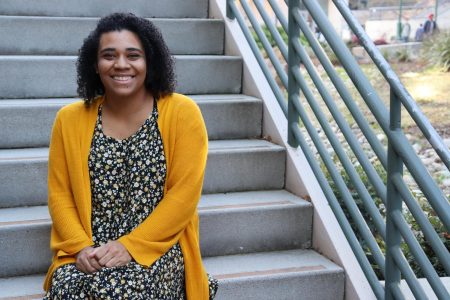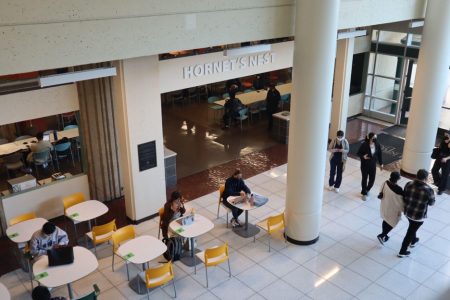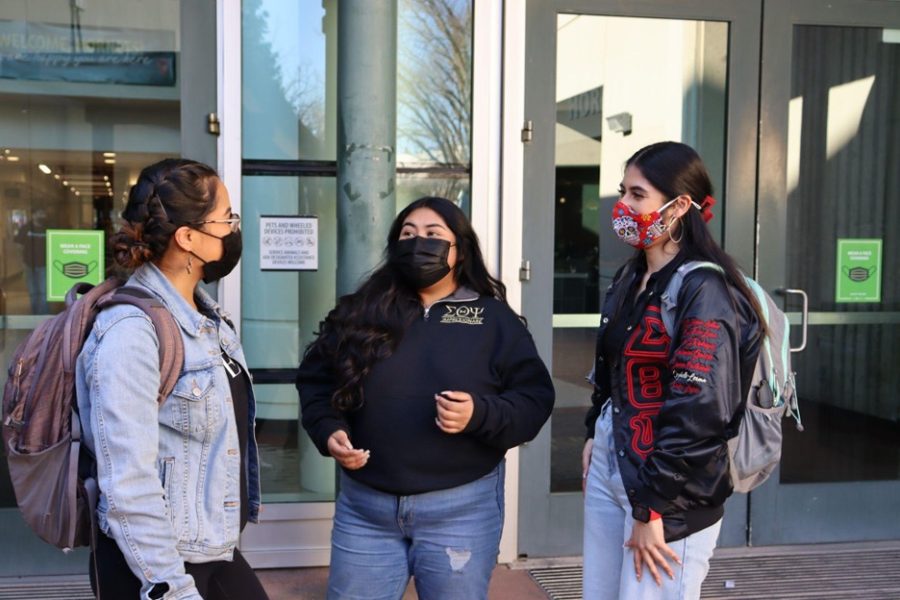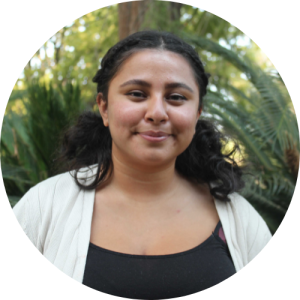Students share their concerns preceding return to in-person learning
Dulce López, a senior nutrition major (left), Gabriela Camargo, a senior communications and Spanish major (middle), and Izabelle Lerma, a senior business major (right), talk in front of the University Union on Monday, Feb. 7, 2022. Sac State students have differing opinions on being back on campus, but the return to in-person instruction mandates many of them to return regardless.
February 8, 2022
Sac State students are concerned with the return to in-person instruction after a Jan. 27 Sac State video detailed COVID-19 expectations for the campus going forward.
“I felt like a lot of it really downplayed a lot of the risks,” said Emily Burruel, a third-year nutrition and dietetics major. “They were likening getting the current most popular variant of COVID, the omicron variant, to a common cold.”
Burruel voiced the same concerns as many others in the comment section of the YouTube video. She said she felt the school isn’t taking the situation of students getting sick very seriously. Burruel said she is worried about the possibility of contracting COVID-19 due to potential exposure to students who may have a positive case but is asymptomatic, which she said she doesn’t see as a worthwhile risk.
Students’ reactions to this announcement were in line with the growing sentiment toward the return to in-person instruction at Sac State. A Change.org petition asking Sacramento State to keep the Spring 2022 semester virtual has reached over 2,500 signatures, and Mills and President Nelsen are aware of it as well.
“I know that many students have a different perspective about coming back, and by the way, there are perspectives in both directions that we’re getting,” Vice President of Student Affairs, Dr. Ed Mills, said about the petition. “I know I can’t satisfy everybody, but I want to consider as many perspectives and as much information as possible.”
Mills and Stewart-James explained that if a student tests positive for COVID-19, they must contact the department of student health where a physician will call them to advise on their next course of action.
If a student is fully vaccinated, they can return to their classes after receiving a negative test after five days or if their symptoms are resolved.
When a student comes into contact with someone who tested positive for COVID-19, they are advised to continue to come to class with a mask until they feel symptoms, according to the student affairs update video.
If a person isn’t up to date with vaccinations, they should quarantine for five days if they have come into contact with someone who has tested positive, according to the Center for Disease Control and Prevention.
Sac State extended the deadline for getting the booster vaccine until Feb. 28 except for those who have been approved for conditional exemptions, according to a COVID-19 booster email that was sent out Dec. 22, 2021.
Cynthia Acosta, a third-year science major, has to wait six months after her second dose of the vaccine to get the booster. She wondered what the procedure would be if a student does get sick.
“[The video] didn’t really mention anything about long COVID or what plans would be in place if one of us got sick, and because most teachers aren’t really accommodating,” Acosta said. “I feel like they kind of just said, ‘Oh, it’s time to get back and be on the same page and if you get COVID it won’t be that bad.”
Terryia Davis, a senior nutrition major, shared similar concerns about accommodations for students who might be out for a long time.

“Lectures can’t be recorded unless it’s a Herky’s Flex class, at least that’s what the professor was telling me,” Davis said. “So if you’re out because you’re sick and you’re out for two weeks, because there’s the quarantine period until you test negative again, that’s a lot of class to miss relying only on classmates.”
Ed Mills addressed some of the students’ concerns in the comment section of the announcement. “I appreciate the comments,” Mills said in regards to the comment section of the video. “I do read them because sometimes students or other individuals will ask a question or make a point that maybe I haven’t thought of or considered.”
Mills said he is always reading student emails, which he said convinced him to extend the booster deadline after some students brought up conflicting advice given by their medical providers.
“I didn’t know that was happening until I read the student comments,” Mills said. “I had students that emailed me and said, ‘Hey, my doctor said this, what am I supposed to do?’”
Mills said that asking professors to record lectures for students who are out for a long time due to COVID-19 complications wasn’t something he could mandate himself since the faculty doesn’t report to him.
According to Mills, a decision to mandate professors to record lectures for absent students would fall on Sac State Provost Carlos Nevarez, were it to come up.

The video also brought up the financial impact of the return to in-person learning. Mills said that it costs a lot to have people either in-person or online.
“It’s costly to go online,” Mills said. “It’s costly to come back from online because then all of those buildings, you reopen them and systems fail and elevators go out. None of this has been inexpensive.”
Regarding the future of online learning, Mills said he doesn’t rule anything out anymore due to the unpredictability of the pandemic and all outcomes are possible.
“Just when we think we see a pattern and that pattern is going to maintain, a new pattern emerges,” said Mills. “I would say all things are always possible.”
































































































































